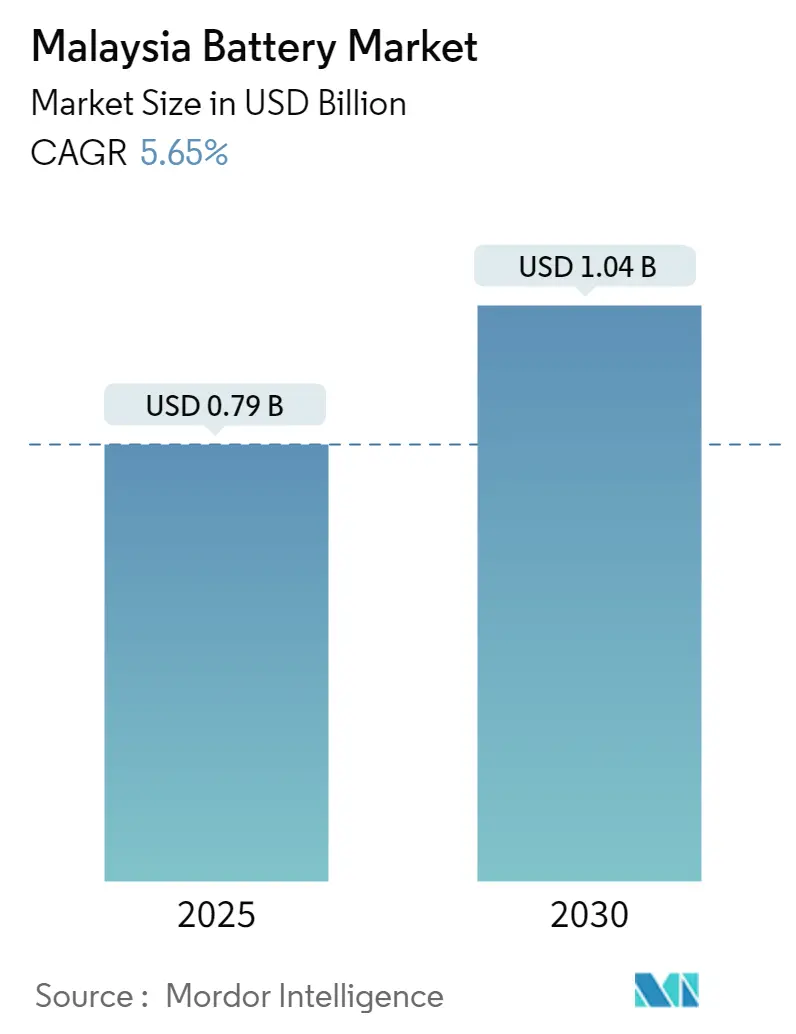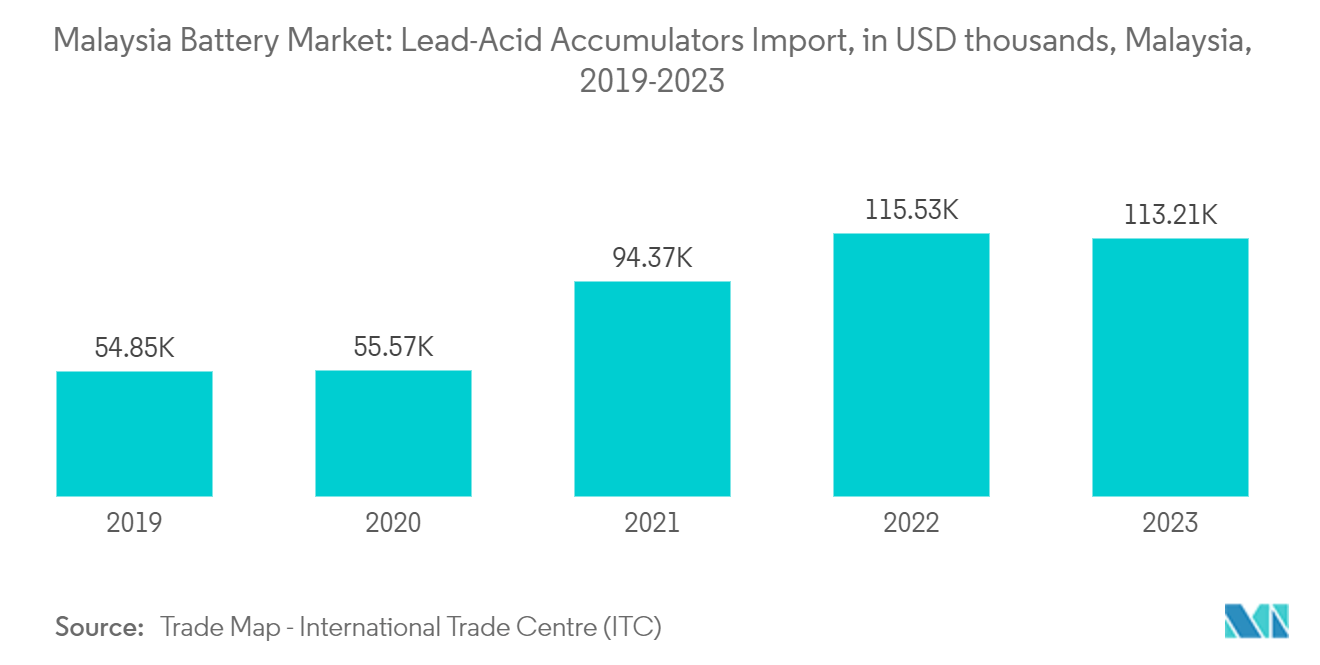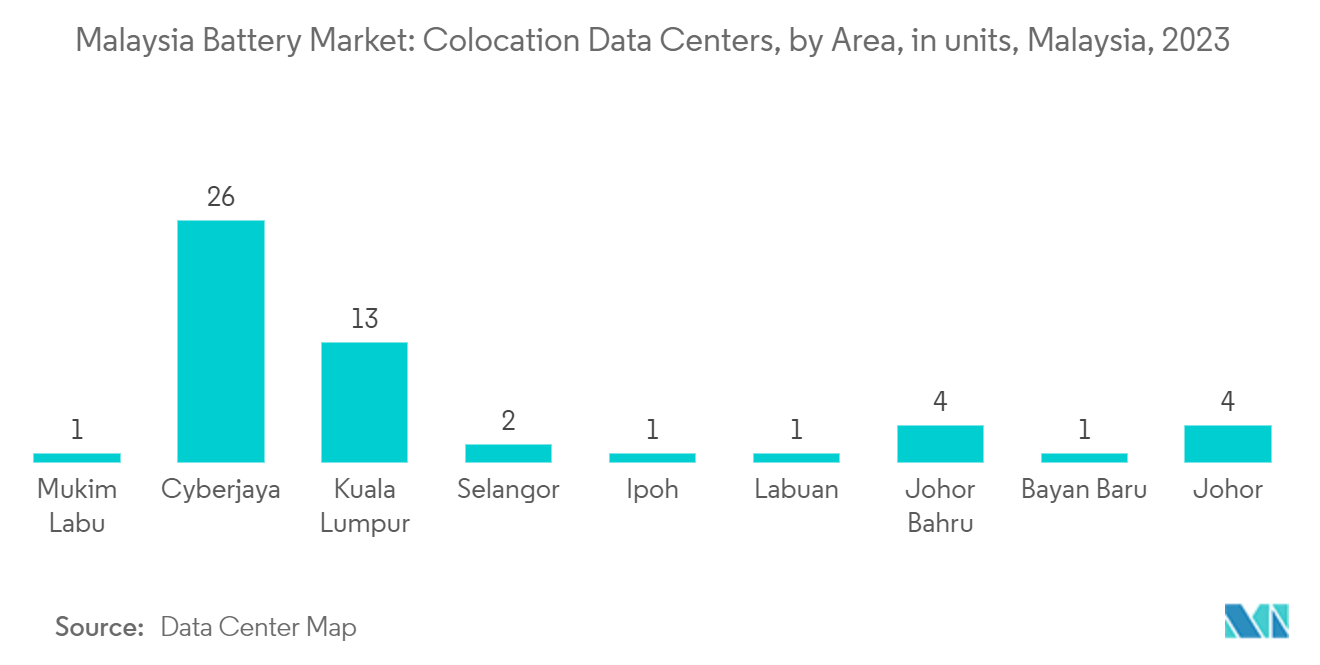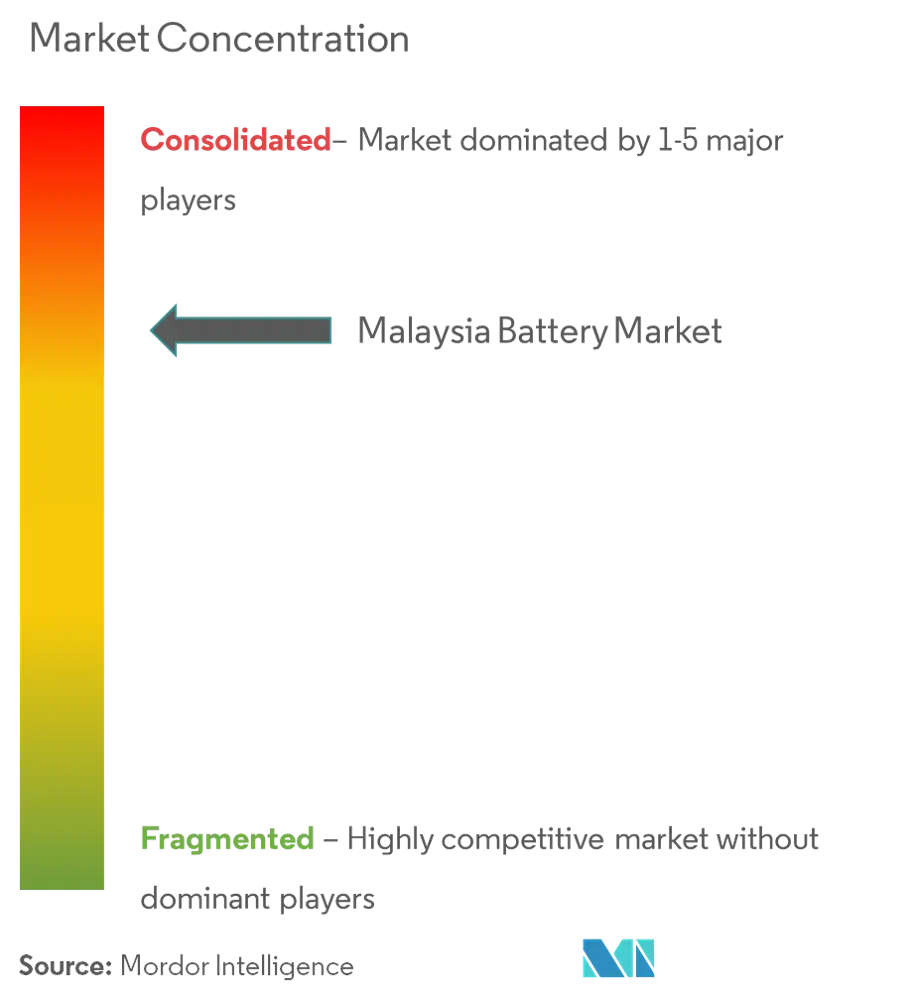
Malaysia Battery Market Analysis by Mordor Intelligence
The Malaysia Battery Market size is estimated at USD 0.79 billion in 2025, and is expected to reach USD 1.04 billion by 2030, at a CAGR of 5.65% during the forecast period (2025-2030).
- In the medium term, factors such as declining prices of lithium-ion batteries and increasing demand for batteries from the automotive industry are likely to drive the Malaysian battery market during the forecast period.
- On the other hand, the demand-supply mismatch of raw materials, like cobalt, lithium, and copper, is expected to hinder the growth of the Malaysian battery market during the study period.
- Nevertheless, technological advancements in new battery technologies to store energy are likely to create lucrative growth opportunities for the Malaysian battery market during the forecast period.
Malaysia Battery Market Trends and Insights
The Lead-acid Battery Segment is Expected to Dominate the Market
- The energy-to-weight ratio of a lead-acid battery is low. However, it can supply large surge currents, indicating a high power-to-weight ratio, which is primarily useful for SLI (Starting Lighting Ignition) applications. Also, lead-acid batteries are preferred when the price is more critical than the energy-to-weight ratio, as they are low-cost batteries. For example, they are selected in backup supplies for mobile phone towers, hospitals, and off-grid remote storage.
- Lead-acid batteries in automotive applications contribute to more than 60% of the market. Automotive (excluding electric vehicles) batteries are mostly SLI batteries. The lead-acid batteries can also be used for in-vehicle entertainment systems, power steering and locking, and power window systems.
- The demand for lead-acid batteries is increasing in Malaysia due to the increasing production and demand for automobiles. The rising demand from automotive and data centers is the primary reason for the increase in the imports of lead-acid batteries in the country. As of 2023, the imports of lead-acid accumulators (excluding spent and starter batteries) accounted for USD 113,211 thousand from different exporting countries like India, China, Japan, Singapore, Thailand, and Germany.
- The most commonly used battery in a motorcycle is the 12V lead-acid battery. Some of Malaysia's preferred brands for the two-wheeler segment are GS Yuasa and Deka AGM Power Sport Batteries. Similarly, the demand for batteries has been increasing for the four-wheeler segment, with the batteries from the Varta brand gaining popularity.
- On the other hand, the government's plans to increase the investment in the charging infrastructure and the policies promoting EV manufacturing facilities may increase the uptake of electric vehicles in Malaysia. This factor may create a significant opportunity for lead-acid and lithium-ion battery manufacturers operating in Malaysia in the long term.
- Therefore, increasing demand from the automotive sector and the plans to set up lead-acid battery manufacturing facilities in the country are expected to drive the lead-acid battery segment during the forecast period.

Increasing Demand from Data Centers is Driving the Market
- Malaysia is considered one of the prime locations for data centers in Asia-Pacific, with a robust telecommunications infrastructure and supportive government initiatives. With the abundant availability of resources and an increasing number of internet users, Malaysia is expected to witness growth in data centers in the coming years.
- With the emergence of 5G and artificial intelligence (AI) and machine learning (ML), new data center construction, deployment, and upgrading efforts in existing data centers are booming. Furthermore, the Malaysian data center market experienced steady growth and is projected to continue over the next five years. The development has been strong from both local and international providers.
- As of 2023, 53 colocation data centers are from 9 areas in Malaysia (Malaysia). Additionally, in February 2024, Bridge Data Centres announced it would expand its presence in the country. The company also acquired new land in Selangor to build its third data center. Thus, the development of new data centers will demand battery support, thereby driving the market.
- The most common and noticeable lead-acid batteries used in data centers are the valve-regulated lead-acid (VRLA) cells. These often come from a vast cabinet of stacked batteries that can support uninterruptible power supply (ups) systems. The standard predicted life of a lead-acid battery is around ten years, while the actual service life is approximately three years. Consequently, lead-acid batteries need constant replacement, raising costs in new cells and admin time over the years. Additionally, lead-acid cells must be kept at around 20 degrees for maximum efficiency, requiring companies to spend massive amounts on air conditioning systems to keep them at optimal temperatures.
- Data centers have recently aimed to increase their power density, given their limitations on space and the need for more efficient operations. Compact lithium-ion batteries reduce the area an uninterrupted power supply system occupies by 50-80%. In addition, such batteries require less time to charge and feature a better self-discharge rate, which plays a significant role during frequent outages. With new solutions and technologies emerging over time, the cost of lithium-ion batteries may decrease further.
- In the future, as the country is moving toward digital transformation, an increase in internet access, smartphone adoption, and robust data infrastructure, the demand for data centers is expected to increase during the forecast period, which is expected to boost the demand for battery usage in data centers.
- Therefore, increasing demand for batteries for power backup applications in data centers and upcoming large-scale data centers in the country are expected to drive the market during the forecast period.

Competitive Landscape
The Malaysian battery market is moderately consolidated. Some key players in the market are FIAMM Energy Technology SpA, GS Yuasa Corporation, ABM Fujiya Berhad, Yokohama Batteries Sdn Bhd, and Leoch Battery Corporation.
Malaysia Battery Industry Leaders
-
GS Yuasa Corporation
-
ABM Fujiya Berhad
-
Leoch Battery Corporation
-
Yokohama Batteries Sdn Bhd
-
FIAMM Energy Technology SpA
- *Disclaimer: Major Players sorted in no particular order

Recent Industry Developments
- April 2024: Leoch International announced the building of two additional lead battery manufacturing plants, one in Malaysia and the other in Mexico. In Malaysia, production test runs for the second plant could start in early 2025.
- May 2023: EVE Energy Co. Ltd signed a memorandum of understanding (MoU) with Pemaju Kelang Lama Sdn Bhd to develop a state-of-the-art manufacturing facility in Malaysia. The plant will be built in Kedah state. According to a joint statement from the Malaysian Investment Development Authority (MIDA) and EVE, it will focus on producing cylindrical lithium-ion batteries for power tools and electric two-wheelers.
- January 2023: Citaglobal Bhd collaborated with Indonesia Battery Corporation (IBC) to develop a battery manufacturing plant and battery energy storage system (BESS) in Malaysia. Citaglobal and IBC's collaboration includes designing, developing, and constructing integrated turnkey production facilities for battery cells, modules, and packs for electric vehicles (EVs).
Malaysia Battery Market Report Scope
A battery is a device that converts chemical energy contained within its active materials directly into electric energy utilizing an electrochemical oxidation-reduction (redox) reaction.
The Malaysian battery market is segmented by technology and application. The market is segmented by technology into lead-acid batteries, lithium-ion batteries, and other technologies. The market is segmented by application into automotive, data centers, telecommunication, energy storage, and other applications (medical devices, power tools, defense, etc.). The market sizes and forecasts for each segment were based on revenue (USD).
| Lead-acid Battery |
| Lithium-ion Battery |
| Other Battery Types |
| Automotive |
| Data Centers |
| Telecommunication |
| Energy Storage |
| Other Applications (Medical Devices, Power Tools, Defense, etc.) |
| Battery Technology | Lead-acid Battery |
| Lithium-ion Battery | |
| Other Battery Types | |
| Application | Automotive |
| Data Centers | |
| Telecommunication | |
| Energy Storage | |
| Other Applications (Medical Devices, Power Tools, Defense, etc.) |
Key Questions Answered in the Report
How big is the Malaysia Battery Market?
The Malaysia Battery Market size is expected to reach USD 0.79 billion in 2025 and grow at a CAGR of 5.65% to reach USD 1.04 billion by 2030.
What is the current Malaysia Battery Market size?
In 2025, the Malaysia Battery Market size is expected to reach USD 0.79 billion.
Who are the key players in Malaysia Battery Market?
GS Yuasa Corporation, ABM Fujiya Berhad, Leoch Battery Corporation, Yokohama Batteries Sdn Bhd and FIAMM Energy Technology SpA are the major companies operating in the Malaysia Battery Market.
What years does this Malaysia Battery Market cover, and what was the market size in 2024?
In 2024, the Malaysia Battery Market size was estimated at USD 0.75 billion. The report covers the Malaysia Battery Market historical market size for years: 2019, 2020, 2021, 2022, 2023 and 2024. The report also forecasts the Malaysia Battery Market size for years: 2025, 2026, 2027, 2028, 2029 and 2030.
Page last updated on:
Malaysia Battery Market Report
Statistics for the 2025 Malaysia Battery market share, size and revenue growth rate, created by Mordor Intelligence™ Industry Reports. Malaysia Battery analysis includes a market forecast outlook for 2025 to 2030 and historical overview. Get a sample of this industry analysis as a free report PDF download.
/malaysia-battery-market---growth,-trends,-and-forecast-(2020---2025)_Companies_-_Malaysia_Battery.webp)


